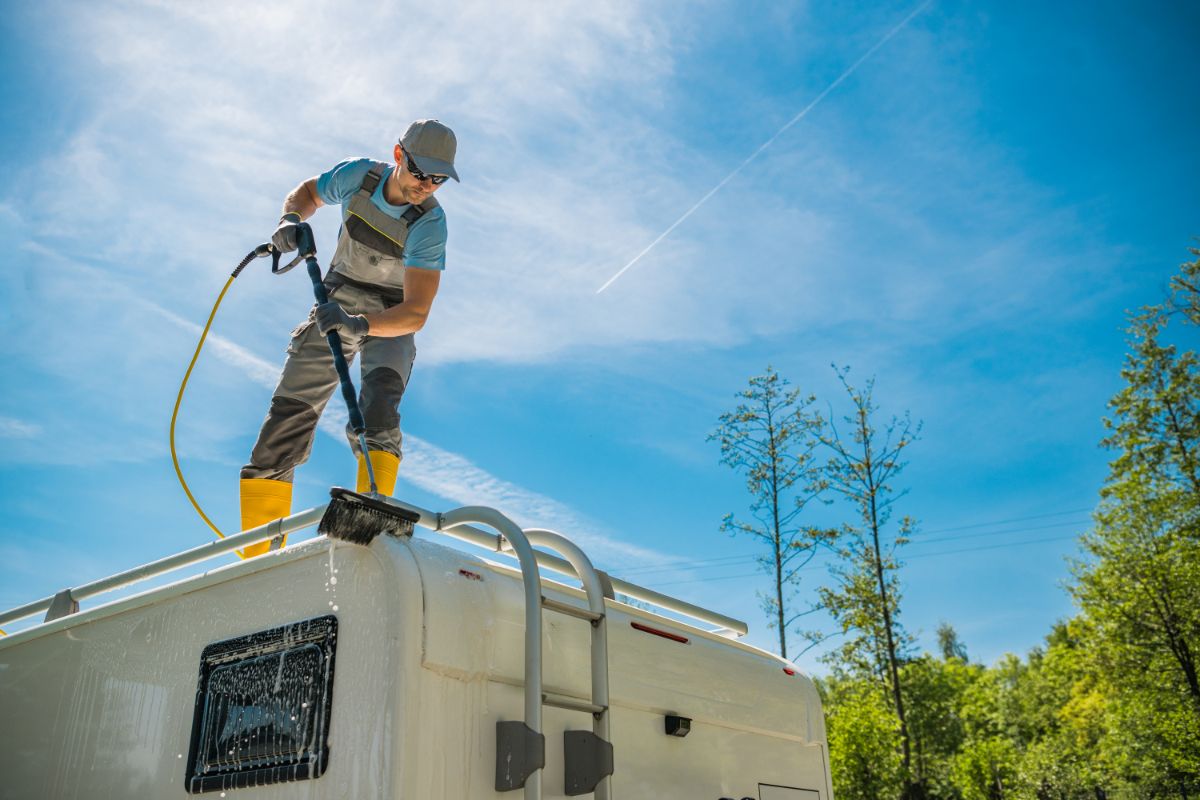Discover How To Use The Power of Authority Marketing To Make You Money While You Adventure!
No Experience, Existing Product Or Technical Skills Are Required
DO YOU BELIEVE ADVENTURES ARE WORTH CHASING?
We're an affiliate.
We hope you love the products/services we recommend on Just Van Life! So you know, there is the possibility we will collect a commission should you make a purchase via any of our links. This will in no way affect the purchase price. Thank you for your support, we really appreciate it!
With a camper, if there are any leaks, you’ll likely find out while you’re out in it, and this can be very unpleasant, which can happen all year round as you never know precisely when sudden rainfall occurs.
That’s why you should ensure your RV’s roof is sealed and prepped for wherever you go, and there are many solutions. But you may wonder which sealant is suitable for you and how to apply it.
That’s why, below, you can find a complete guide on how to pick out the suitable one for you and how you can preserve your roof even further to prevent any weather damage or faults due to general wear and tear.
What Kind Of Roof Do You Have?
Before you buy any adhesive or sealant, you should have a good idea of the material your roof is made of, as some bonds work better than others on certain surfaces, and the best way to find out is by the age of the camper.
If you have a camper ten-plus years old, it’s a good chance that the material is made of either rubber, steel, or aluminum. For more recent ones, they mostly have fiberglass, which you may find is an easier material to work with but can be heavier than aluminum.
Clean And Add Patches To The Roof
For this, you need a stepladder and adequate access to all areas of your roof, and you can find cleaners at hardware or RV-based stores. So you’re looking for one that works best for your roof, which can be found on the cleaner label.
For cleaning equipment, you want to avoid using harsh abrasives, especially if your roof is made of rubber, and for the cleaner, look out for citric ingredients, as these might have an adverse reaction to any other cleaner you use.
Apply The Right Adhesive
Once you’ve applied and sprayed all the dirt off, you can get to work on any cracks or rips in your roof, and for this, you can use sealing tape or specifically made patches that are waterproof and act as adhesives which you can use sealant on the edges to keep it in place.
When looking at sealant, you want to make sure that it’s compatible with your roof, and you should check around the trim, the membrane, vents, and air conditioning outlets for any tears or cracks.
For the roof joints and outlets, you can use a self-leveling lap sealant, weather-resistant, and a low-emission adhesive sealant. Be sure to find one resistant to mold, aging, and UV rays and doesn’t damage any paint or plastic when applied or needs to be replaced.
Use Tape Sealant If Needed
Once you’ve finished with this section, you can turn your attention to any fittings and outlets and use mastic tape or permanent repair tape to reseal and re-bed any edges or trimming that feels flimsy or could be a problem during heavy rain.
Be sure to check these spots across your RV, and you may find some overlapping joints that need to snap back into place, and using tape sealant can keep them from becoming more of a problem as time goes on.
You should also look inside your camper and check for any gaps or loose fittings, as the tape and sealant we have discussed earlier have applications inside as well, as these work with plastic and wood fittings.

Use Coating To Seal It Even Further
Now you’ve got your camper sealed up. You can add a roof coating which you can find in stores, which is made specifically for this purpose, but first, be sure the layer will work for your roof material as it should be clear on the label what it’s ideal for.
Before applying it, your roof should be completely dry and free of any mold for the best results, and you can use a long paint roller to apply it without having to walk on the roof.
With the first coat on, you should wait between 2-3 hours to let it set, then you can apply a second layer, and after 4 hours, you should have a fully covered roof.
For the best results, you can leave it in the sun to dry or in a garage if it’s wet outside, and avoid using the camper for around 24-48 hours after applying it.
Use RV Covers For More Protection
Investing in a roof covering usually made from polypropylene fabric might also be wise. It provides all-year-round protection from harsh weather conditions, intense sunlight, and mold that can develop when not used.
If you go to an RV dealership, you can find out where you can find these covers, and in some cases, you can get custom-made ones, so you won’t have any parts flying around if your RV is outside and exposed to heavy winds, for example.
How Often Should I Check For Leaks?
It makes sense to check before you decide to use it, and during the off-season, it doesn’t hurt to check every 4-6 months.
In general, if you’ve sealed it right, you shouldn’t have to replace it for another ten years, which will be a big weight off your shoulders. Be sure also to check other parts of the camper, like the caulking or trims along the RV, for cracks.
Closing Thoughts
Now you know how to fix and maintain a camper roof, you can go on your trips without fear of any leaks forming, and you will find eventually that keeping your roof maintained will prevent any rattling and make it even more efficient with its energy.
This can keep running costs low and means you don’t have to worry about major repair costs as this can be something avoidable, so like your home, your camper can be the pride of your life.
Discover How To Use The Power of Authority Marketing To Make You Money While You Adventure!
No Experience, Existing Product Or Technical Skills Are Required
DO YOU BELIEVE ADVENTURES ARE WORTH CHASING?
